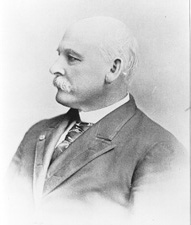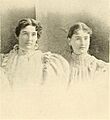George L. Shoup facts for kids
Quick facts for kids
George Shoup
|
|
|---|---|
 |
|
| United States Senator from Idaho |
|
| In office December 18, 1890 – March 3, 1901 |
|
| Preceded by | Seat established |
| Succeeded by | Fred Dubois |
| 1st Governor of Idaho | |
| In office October 1, 1890 – December 18, 1890 |
|
| Lieutenant | N. B. Willey |
| Preceded by | himself (Governor of Idaho Territory) |
| Succeeded by | N. B. Willey |
| 12th Governor of Idaho Territory | |
| In office April 30, 1889 – July 3, 1990 |
|
| President | Benjamin Harrison |
| Preceded by | Edward A. Stevenson |
| Succeeded by | Himself (as Governor of Idaho) |
| Personal details | |
| Born | June 15, 1836 Kittanning, Pennsylvania, U.S. |
| Died | December 21, 1904 (aged 68) Boise, Idaho, U.S. |
| Resting place | Pioneer Cemetery, Boise |
| Nationality | United States |
| Political party | Republican |
| Spouses | Magdalena "Lena" Darnutzer Shoup (1844–1927) (m. 1868–1904, his death) |
| Children | 6 |
| Signature | |
| Military service | |
| Allegiance | Union |
| Branch/service | Union Army |
| Years of service | 1861–1864 |
| Rank | |
| Unit | 3rd Colorado Cavalry |
| Battles/wars | American Civil War Indian Wars |
George Laird Shoup (born June 15, 1836 – died December 21, 1904) was an important American politician. He was the very first Governor of Idaho. Before that, he was the last governor of the Idaho Territory. After Idaho became a state in 1890, he became one of its first United States Senators.
Contents
Early Life and Family
George Shoup was born in Kittanning, Pennsylvania, which is a town northeast of Pittsburgh. He went to public schools there. In 1852, when he was 16, he moved to Galesburg, Illinois, and worked on a farm with his father.
On June 15, 1868, George Shoup married Magdalena "Lena" Darnutzer from Iowa. They had six children together: three sons and three daughters named Lena, Laura, and Margaret.
A Busy Career
Moving West and Mining
In 1857, George Shoup faced money problems. So, in 1859, he moved to the Colorado Territory. He worked in mining and selling goods near Pikes Peak and later in Denver. He was looking for new opportunities in the West.
Military Service
During the American Civil War, George Shoup joined the military. He worked as a scout in places like New Mexico Territory, Colorado Territory, and Texas. In 1861, he became a second lieutenant in the 3rd Colorado Cavalry Regiment. He later became a colonel before leaving the military in December 1864.
He took part in some important military actions. These included the Battle of Apache Canyon in New Mexico Territory during the Civil War. He also participated in military actions during the Colorado War.
Life in Idaho
After the war, Shoup moved to Virginia City, Montana. Then he settled in Salmon, Idaho, which was in the Idaho Territory at the time. He even helped to start the city of Salmon! He owned stores that sold many different kinds of goods in both places.
George Shoup was chosen to help organize Lemhi County, Idaho. In 1874, he was elected to the territorial legislature, which was like the local government. He also served on the Republican National Committee for Idaho for many years, from 1880 to 1904.
Becoming Governor and Senator
In April 1889, President Benjamin Harrison chose George Shoup to be the governor of Idaho Territory. He held this job until July 1890. That's when Idaho became a state, and the Idaho Territory no longer existed.
In October 1890, George Shoup was elected as the very first Governor of the new state of Idaho. He was governor for only a few weeks. In November 1890, the Idaho Legislature elected him to the U.S. Senate. He resigned as governor in December to start his new job as a Senator. N. B. Willey, who was the lieutenant governor, took over as governor.
George Shoup served in the U.S. Senate for more than ten years, from 1890 to 1901. He was interested in many topics, including pensions for soldiers, education, and military matters. He was also the chairman of the Committee on Territories. In this role, he worked to make sure Native Americans were treated fairly.
He was reelected to the Senate in 1895 for a full six-year term. However, in 1901, he lost his reelection bid to Fred Dubois. After that, he retired from public life and lived in Boise.
Two years later, in 1903, Shoup tried one more time to become a U.S. Senator. He decided not to continue in the race and supported Weldon Brinton Heyburn instead.
Death
George Shoup passed away in Boise, Idaho, on December 21, 1904, when he was 68 years old. He had a state funeral in Idaho. He is buried in Boise's Pioneer Cemetery, next to his wife, Lena.
Legacy
Honors and Memorials
In 1910, the state of Idaho gave a marble statue of George Shoup to the National Statuary Hall Collection at the United States Capitol. This is a special place where each state can honor two important people.
The small community of Shoup, Idaho, located on the Salmon River, was named after him in 1882. During World War II, a Liberty ship (a type of cargo ship) was named S.S. George L. Shoup in his honor. It was launched in May 1943. Also, a new men's dormitory at the University of Idaho in Moscow was named for him in 1958.
George Shoup's important papers were given to the University of Idaho. His grandson, G. Elmo Shoup, presented them.
Images for kids



